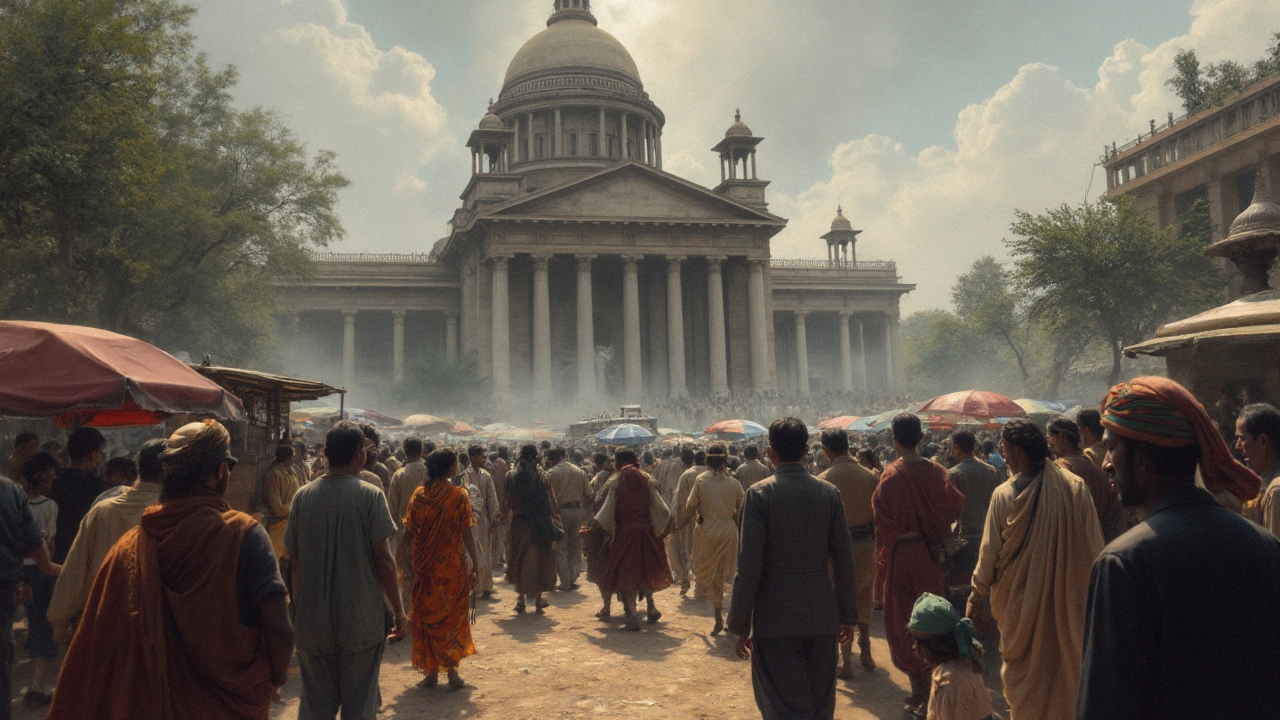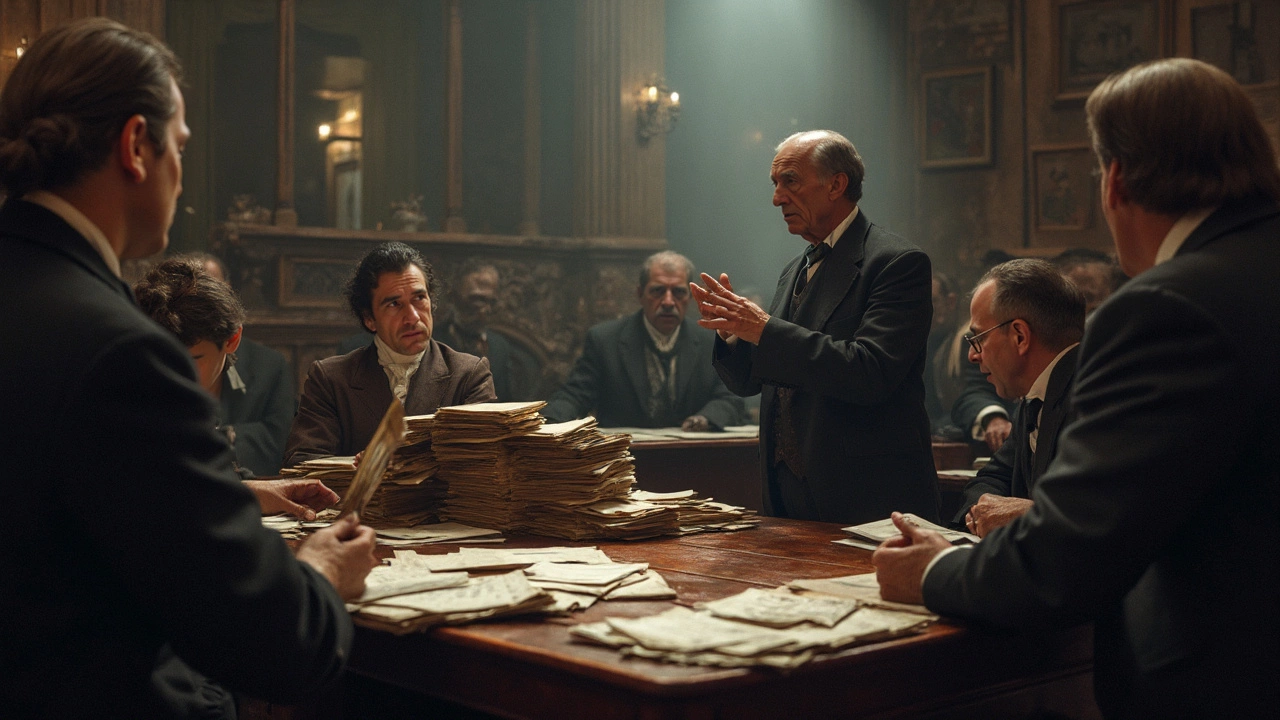If you've ever felt stuck in a slow-moving system, you’d get why Charles Dickens wrote 'Bleak House.' The story rips into the problems of the Court of Chancery—a real court in Victorian England famous for dragging people through years (sometimes lifetimes) of paperwork and nonsense. Dickens takes this dry legal maze and fills it with families, heartbreak, and drama. It's not just a long, old story—it's an eye-opener about how people get crushed while waiting for justice.
Don't worry if you haven’t tackled a 900-page Victorian novel lately. At its core, 'Bleak House' is about unfair systems and why it matters to fight them. Dickens isn’t only showing you musty courtrooms—he’s selling the idea that ignoring messed-up systems hurts everyone, not just the poorest. Ready to see how his message still hits home today? Let's go beyond the cover and find out what Dickens really wanted you to remember.
- Why Dickens Wrote Bleak House
- The Infamous Court of Chancery
- How Bleak House Paints London Life
- Key Characters and What They Represent
- Dickens' Style and Satire Explained
- Why Dickens’ Message Still Matters Now
Why Dickens Wrote Bleak House
Charles Dickens didn’t write Bleak House just to entertain. He was on a mission. In the 1850s, he’d seen too many lives wasted by the real-life Chancery Court, a place that tangled up lawsuits for decades. People joked about cases that outlived the people in them. Dickens actually visited courts, saw the mess, and decided it was time to call out this broken system.
Here’s a wild fact: one of the longest real Chancery cases, called Jennens v. Jennens, dragged on from 1798 to 1915. That’s over a hundred years—longer than most people lived back then! Dickens took inspiration from this, knowing most readers could relate to getting the runaround from “the system.”
It wasn’t just about courts. The 1850s were packed with reports on public health, city poverty, weird government inspections, and a bunch of reforms that didn’t always work. Dickens got fed up. In Bleak House, he grabs all that frustration—lawyers, city officials, charities, even doctors—and throws it into one massive story to show how regular folks get trapped by clueless or selfish people in charge.
For Dickens, writing was a way to push for change. Bleak House is a protest as much as it is a novel.
The Infamous Court of Chancery
The real villain in Bleak House isn’t just one person—it’s the Court of Chancery itself. This court handled things like wills and estates in Victorian England, but it got famous for being painfully slow, expensive, and complicated. People would get tangled up for years in lawsuits, often losing everything in legal fees before anything was decided. Sounds pretty broken, right?
If you flip open almost any history book about the 1800s, you’ll find people complaining about Chancery. Dickens wasn’t making this stuff up. Cases could drag on so long that kids involved would turn into adults or even die before seeing a penny. One statistic that hits hard: around 20,000 cases were pending in Chancery by the 1840s—that’s a mountain of paperwork and misery.
| Year | Cases Pending |
|---|---|
| 1820 | 8,000 |
| 1840 | 20,000 |
In the very first chapter of Bleak House, Dickens throws you right into this mess. The fictional case Jarndyce and Jarndyce is just one example, but it stands for thousands of real families left in legal limbo. As one modern historian put it:
"Chancery was not simply inefficient; it wrecked lives and fortunes on an industrial scale." — David Olusoga, British historian
Why does Dickens spend so much time attacking the court? Because these open-ended lawsuits were more than a paperwork problem—they were a disaster for regular people. He wanted his Bleak House readers to see how real families were getting stuck, so it wasn’t just fiction; it was a warning about what happens when systems stop working for the people who need them most.
How Bleak House Paints London Life
When it comes to showing what London was really like in Dickens' time, Bleak House doesn't mess around. Dickens throws you right into the city’s streets, from filthy alleys and crowded tenements to stuffy mansions and smoky law offices. He actually walked these roads himself—he wasn’t guessing how the city felt, smelled, or sounded. The novel brings you face-to-face with fog—not just the literal smog choking the city, but also the confusion hanging over everyone caught up in the legal mess.
He points out problems like poverty, disease, and pollution, shining a light on people that society usually ignored. Small details make the difference. For instance, the character Jo, a homeless crossing-sweeper, isn’t just background noise. Dickens gives Jo a voice, making it clear that children like him really existed, fighting for survival every day.
| London in the Time of Bleak House | Fact |
|---|---|
| Population | Around 2.5 million people by 1851 |
| Child mortality rate | Roughly 1 in 3 children died before age five |
| Main source of pollution | Coal fires |
| Sanitation | No modern sewer system until late 1850s |
Don’t overlook the extremes Dickens packs in. One chapter might show the endless grind of a poor clerk, while another offers a peek at parties in houses with more rooms than some families had bread. The sharp contrast underlines how unfair things were. When you see Lady Dedlock driving past a crowd of desperate kids, Dickens is practically shouting—London was divided, both rich and poor sharing the same fog, but almost nothing else.
- Want to picture the real London behind Bleak House? Imagine crowded courts, overflowing cemeteries, and children working the streets.
- The novel exposes how easy it was for kids and workers to slip through the cracks, while the wealthy shut themselves away.
This isn’t just a grim tour, though. Dickens hoped readers would see these realities and care enough to push for change. By making the city itself a character—dirty, fascinating, and alive—he made sure that nobody could look away from the truth. That’s why Bleak House still sparks conversations about justice and social change in big cities everywhere.

Key Characters and What They Represent
Dickens doesn’t mess around with forgettable characters in Bleak House. Each main player stands for something bigger, often showing exactly who gets tangled up or trampled by the Victorian system.
Esther Summerson is the real heart of the novel. She’s kind, reliable, and often overlooked. Through her everyday choices, Dickens gives us a normal person’s view of life inside a broken system. She represents hope, steady values, and the idea that decency can survive even when the world feels cold.
John Jarndyce is another standout. He tries to help others stuck in the endless lawsuit—always supportive and never greedy. Think of him as Dickens’ perfect example of personal responsibility: if the system won’t help, good people have to step up and support each other.
Lady Dedlock seems distant at first, sitting high in society, but her personal secrets and regrets bring her life crashing down. She’s a warning about appearances—no amount of wealth or status can shield you from bad choices or the system’s cruelty. Dickens reminds us that even the upper crust isn’t safe from injustice.
Now, Mr. Tulkinghorn—the cold, unyielding lawyer—embodies the legal world Dickens despised: stubborn, secretive, and more interested in power than fairness. He’s exactly what’s wrong with the Court of Chancery; all rules, no heart, and zero flexibility. If you’ve ever dealt with a stubborn bureaucrat, he’ll feel familiar.
Then there’s Richard Carstone, a young man driven in circles by the wretched lawsuit. He shows what happens when people put all their faith in a broken system: wasted time, wasted talent, and wasted life. Bleak, but real—Victorian readers knew people like Richard.
If you want extremes, look at Mrs. Jellyby. She’s obsessed with far-off charity work while ignoring her own family and neighbors. Dickens uses her to poke fun at “do-gooders” who skip the people right in front of them. Her character pushes us to help at home, not just in places that sound impressive.
Here's a quick breakdown:
| Character | What They Represent |
|---|---|
| Esther Summerson | Hope, decency, resilience |
| John Jarndyce | Personal responsibility, kindness |
| Lady Dedlock | The limits of wealth/status |
| Mr. Tulkinghorn | Legal corruption, power without empathy |
| Richard Carstone | Victims of a broken system |
| Mrs. Jellyby | Misplaced priorities in charity |
These characters help carry Dickens' main message in Bleak House. They make the whole thing feel real, honest, and surprisingly close to what many people still deal with today—whether you’re stuck in a mess of red tape or just trying to make a difference at home.
Dickens' Style and Satire Explained
When people talk about Bleak House, Dickens’ writing style can’t be ignored. He’s got a way of mixing dark humor with withering criticism. You see it in the way he describes the fog in London—it’s not just bad weather; it’s a symbol for the confusion and mess of the legal system. He uses details that stick with you, like endless piles of paperwork or lawyers who talk in circles until nobody remembers what the case was about.
Dickens splits the story into two voices: the third-person narrator, who’s blunt and sharp, and Esther Summerson, who’s more gentle and personal. This switch keeps things fresh, but also shows the same world through different eyes. For readers, it’s a reminder that big problems feel different depending on where you stand.
As for satire, Dickens doesn’t hold back. He skewers the Court of Chancery by turning it almost into a comedy show—if it weren’t so sad. Characters like Mr. Krook (“the Lord Chancellor of rag and bottle shop”) are absurd, but there’s always a jab at real institutions. Dickens even made up wild names like “Tulkinghorn” and “Smallweed” to poke fun at the people in charge. Names in Bleak House are rarely just names—they tell you right away what kind of person you’re dealing with.
What really sets Dickens apart is how he uses little moments to spotlight big issues. For example, he doesn’t just say the system is slow; he shows it ruining lives. Check out this stat:
| Real Chancery Case Duration | Longest Known Length |
|---|---|
| Actual cases from 1800s | Over 20 years |
| Average Bleak House court case | Never really ends |
If you find Dickens’ style over the top, that’s on purpose. He’s exaggerating to make the pain and frustration impossible to ignore. The satire works because it’s so close to reality—Victorian readers recognized these problems right away, and people now still spot echoes of them everywhere, from government offices to customer service lines.
Want to really get Dickens? Read with an eye for the jokes and the anger behind them. He wants you to laugh, but he’s also itching for justice. It’s the mix of humor and real outrage that gives Bleak House its punch.
Why Dickens’ Message Still Matters Now
It's wild how a novel from 1853 keeps turning up in conversations about the world today. The problems in Bleak House—clogged legal systems, families stuck in paperwork nightmares, no one taking responsibility—feel just as real now. Dickens hit a nerve by showing how broken systems don’t just hurt individuals. They waste money, time, and even lives. If you’ve ever seen government work grind to a halt or people give up because they can't afford a lawyer, you’re basically watching a modern Chancery drama play out all over again.
Recent studies back this up. In 2023, a UK survey revealed that over half of people facing legal issues delayed seeking help because the process was too complicated or expensive. Sure, it’s not Victorian England, but Dickens’ warnings about injustice still stick. When rules get too messy to follow—or are built to serve just a select few—everyday people lose out. He basically shouts: if you don’t fix this, real people pay the price.
You might spot Dickens' fingerprints on pop culture and politics, too. Ever binge-watched a show about fighting bureaucracy, or read a news story about someone stuck in a broken system? Those stories have Dickens’ DNA. He wanted readers to get fed up enough to demand change. In fact, 'Bleak House' actually helped fuel movements for legal reform in Britain. Just a few years after the novel, parts of the Court of Chancery were finally reformed thanks to public pressure—Dickens made the problem too obvious to keep ignoring.
So what can you do when you see Dickens’ world everywhere? It’s not all doom and gloom. He believed things could change. If you want to be part of the fix, speak up when the system’s not fair, support groups trying to untangle legal red tape, or help someone fight paperwork hurdles. Even being aware is a step—ignorance is exactly what lets bad systems stick around. That’s the heart of Dickens’ message: don’t just watch. Get involved.
| Year | Legal Cases Stuck in UK Courts | Main Reason Cited |
|---|---|---|
| 2019 | 54,000+ | Bureaucratic backlog |
| 2023 | 68,000+ | Complex processes, lack of funding |
Those numbers should ring a bell. Even with all the tech and reforms, some things haven’t changed much since Dickens put pen to paper. Maybe that's why Bleak House still feels so fresh, even for a book that’s been around for over 170 years.

